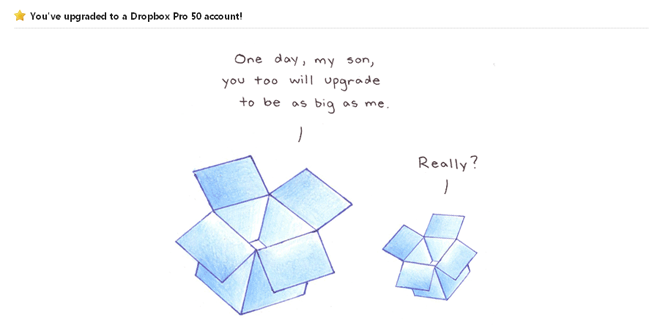Corporate Customer Experiences Need Startup Mojo
I’m a Dropbox customer. I originally signed up for the basic plan — 2 GB for free — but ran out of space quickly and decided to upgrade to 50 GB of storage. So I forked over my $99 and got the following confirmation page:

A gold star! A hand-drawn cartoon! Now I know this page wasn’t designed specifically for yours truly, but when I saw it, I felt special. Like the people at Dropbox actually gave a damn that I had just given them $99 of my hard-earned money.
Compare that with the $700 I spent recently for several nights at a large hotel. My final bill was printed on a plain white sheet of paper and was so devoid of any brand messaging that I feared it would raise eyebrows with our finance department! Consider the $1,600 I just plunked down for a multi-leg transcontinental flight. The airline’s confirmation email didn’t waste any time trying to sell me on a rental car, hotel room, and credit card — but didn’t even wish me a pleasant trip. Or take my credit card company — which processes tens of thousands of dollars of business expenses for me each year. When I look at my bill, the things that pop out are how much I owe them, by when, and a late payment warning — key pieces of information, yes, but reading that bill leaves me feeling like I need a shower.
These small touchpoints — a receipt, a confirmation email, a bill — play a functional role in customer interactions. But they also represent prime opportunities for companies to reinforce their brands and (perhaps even more importantly) make customers feel good about where they spend their time and money.
So many startups do it right. I’m thinking of Twitter’s fail whale, which makes service disruptions somewhat enjoyable, Groupon’s exclamation of “That’s Wonderful!” when I make a purchase, and Zipcar’s big orange “Congratulations, you're done!” message at the top of the reservation confirmation page.
But large corporations, more often than not, waste these precious opportunities because:
- The complexity of the customer experience ecosystem has crippled them. Want to change the wording on a page of a big corporate website? You’ll need to consult with five different lines of business, the marketing and brand teams, the SEO folks, the web designers, the content management team — and don’t forget legal. While all of these people play an important role, too many good ideas cave to organizational complexity.
- They’re overly focused on ROI. Dropbox’s cartoon made me so happy that I’m honestly looking forward to the next time I need to upgrade. (Will the little box be that much bigger? I’m dying to know!) And how much did this really cost the company? Perhaps it cost a couple of hours for someone to sketch and scan the image and another couple of hours to code and test the very simple page change — work well suited for a trusted (but cheap) intern.
- They’ve lost track of time. Startups treat every day as a new opportunity to add customers and turn their balance sheets black — and often work around the clock to make it happen. In contrast, large corporations work on glacial time. Initiatives span multiple years, and employees’ day-to-day activities center around emails, reports, and meetings — not on making changes to real customer interactions.
So start thinking like a startup. What will you do today to directly improve your customer experience? (Seriously, tell me.)